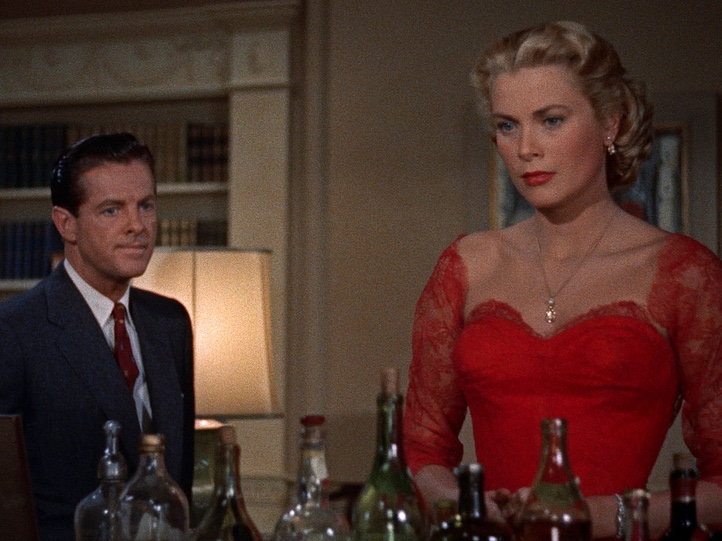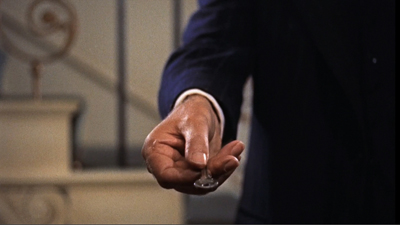
When playboy tennis pro Tony Wendice discovers his rich wife, Margot, is having an affair with handsome American Mark Halliday, he devises an ingenious plot to murder her. But when his scheme takes an unexpected, deadly twist, Tony improvises – implicatingMargot for first degree murder in this classic spellbinder.
EN
“Hitchcock had already experimented with plots confined to tight quarters – a lifeboat (Lifeboat, 1944) or a parlor and hallway (Rope, 1948). It’s plausible, as many critics have noted, that he tried the same thing with Dial M. But those earlier films seem more technically radical. [...] From this perspective, Dial M can look like a retreat. It expands its range of action in modest ways, and it doesn’t try for a consistent long-take look. [...] In adapting a play, there's always a temptation to open things up. Most plays include a great deal of action that takes place before the play's opening scene, or in other locales offstage. [...] Hitchcock resisted the temptation to open out the play. Showing scenes that take place before the stage action (perhaps the theft of Margot's handbag, or Tony's stalking of the shady Swann/ Legate) would have lost the tight focus of the original. Moreover, we can gain an extra layer of interest when action is recounted rather than dramatized: we get both past events and present attitudes toward them. Most intriguing, though, is Hitchcock's comment to Truffaut that opening up a play "overlooks the fact that the basic quality of any play is precisely its confinement within the proscenium." Hitchcock wanted "to emphasize the theatrical aspects."
[...]
Hitchcock wasn't alone. In the 1940s, several filmmakers were rethinking the problem of filming theatre, and they were exploring ways to bring out the "theatrical aspects" of the material. In a brilliant 1951 essay, André Bazin pointed out that filmmakers were now confident enough in their creative choices to adapt plays while acknowledging the pleasure of purely theatrical conventions. These films, he suggests, engage us by acknowledging the theatricality of theatre.
Bazin pointed to Olivier's Henry V (1944), which begins in an Elizabethan playhouse and gradually moves its scenes to realistic settings. He mentioned as well Cocteau's Les Parents terribles (1948), which, somewhat in the manner of Dial M, finds an equivalent for the play's single-room set by expanding the film's locale just slightly to take in an entire apartment.”
David Bordwell1
- 1David Bordwell, “Dial M for Murder: Hitchcock frets not at his narrow room,” davidbordwell.net, 7 September 2012.
NL
“François Truffaut: We zijn nu in 1953 aanbeland, het jaar van Dial M for Murder...
Alfred Hitchcock: ... waar verder niet veel over te zeggen valt.
Truffaut: Dat ben ik niet met u eens, zelfs niet als hij alleen maar gemaakt werd omdat dat toevallig goed uitkwam.
Hitchcock: Ik zocht weer dekking. Ik had een contract met Warner Brothers, en werkte aan een scenario met de titel The Bramble Bush. Over een man die het paspoort van een ander had gestolen zonder te weten dat diegene gezocht werd voor moord. Daar heb ik me een tijdje over gebogen maar dat werd niks. En toen ontdekte ik dat Warner Brothers de rechten hadden gekocht van een Broadway-succes: Dial M for Murder. Ik heb onmiddellijk gezegd dat ik het wilde hebben, want ik wist dat ik daarmee wel op safe kon spelen.
Truffaut: Er werd heel snel gedraaid, nietwaar?
Hitchcock: In zesendertig dagen.
Truffaut: Interessant is dat de film in 3D opgenomen werd. Helaas kregen we in Frankrijk alleen de platte versie te zien, omdat bioscoopbazen te lui waren om de benodigde Polaroid-brillen aan het publiek uit te delen.
Hitchcock: Vooral in de lage shots kreeg je de indruk van een reliëf. Ik heb ze een gat laten maken, zodat de camera op het niveau van de vloer kon staan. Verder waren er heel weinig effecten direct in reliëf.
Truffaut: Maar onder andere wel van een lamp, een bloemenvaas, en vooral van een schaar.
Hitchcock: Ja, als Grace Kelly een wapen zoekt om zich mee te verdedigen. Dan was er nog een shot van het sleutelgat, en dat was alles.
Truffaut: Was de film ook erg trouw aan het originele toneelstuk?
Hitchcock: Ja. Over films die op toneelstukken gebaseerd zijn heb ik namelijk een theorie die ik al ten tijde van de stomme film toepaste. Veel filmers nemen een toneelstuk en zeggen: “Hier ga ik een film van maken.” Dan beginnen ze het “open te breken”. Dat wil zeggen, op het toneel is alles beperkt tot één set, en daar willen ze van loskomen.
Truffaut: In Frankrijk noemen we dat het toneelstuk “ventileren”.
Hitchcock: Ja, maar die hele operatie heeft weinig nut. Stel dat er in het stuk iemand in een taxi aankomt. In de film laten ze dan de komst van de taxi zien, de man komt eruit en betaalt de chauffeur, loopt de trap op, klopt op de deur en komt de kamer binnen. Dit dient dan om de lange scène in te leiden die in de kamer volgt. Als een personage bijvoorbeeld iets heeft gezegd over een reis, dan laat de film die reis in een flash-back zien. Daarmee zien ze de basis-kwaliteit van het toneelstuk over het hoofd, namelijk de beperkingen van de gehele handeling tot een enkele plek.
Truffaut: Overigens is die beperking ook het moeilijkste hanteerbaar. En regelmatig zie je dan ook dat het hele effect van een stuk verdwijnt als er een film van wordt gemaakt.
Hitchcock: Ja, daar gaan filmers regelmatig fout, en zien we oervervelend filmmateriaal dat kunstmatig aan het stuk is toegevoegd. Terwijl ik in Dial M for Murder juist mijn best heb gedaan niet naar buiten te gaan. Dat gebeurde eigenlijk maar twee of drie keer, en dan ook nog heel kort, toen de inspecteur iets moest checken.”
François Truffaut en Alfred Hitchcock in gesprek1
- 1François Truffaut, Alfred Hitchcock, Hitchcock/Truffaut (Amsterdam: International Theatre Bookshop, 1988), 175-176. Vertaald door Loes Goedbloed.


